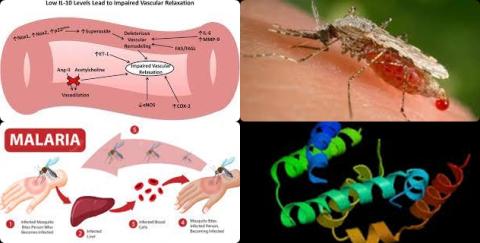
Objectives:
The roles of anti-inflammatory cytokines in the pathogenesis of severe malaria have been widely studied and the role of IL-10 in the pathogenesis of severe malaria remains unclear. Therefore, this review article has been conducted.
Is there a difference in IL-10 levels between patients with severe malaria and those with non-severe malaria?
Study design:
This review article included 19 studies, published between 1994 and 2021.
11 studies (57.9%) were prospective studies, 6 (31.6%) were retrospective studies and 2 (10.5%) were cross-sectional studies.
Of the included studies, 10 (52.6%) were conducted in Africa, 5 (26.3%) were conducted in Asia, 3 (15.8%) were conducted in the United States and 1 (5.26%) was conducted in Europe.
13 studies (68.4%) enrolled patients infected with P. falciparum, 4 (21.1%) enrolled patients with P. vivax, and 2 (10.5%) enrolled patients with both P. falciparum and P. knowlesi.
10 studies (52.6%) enrolled children, 6 (31.6%) enrolled adults and 3 (15.8%) enrolled all age groups.
18 studies (94.7%) were high-quality studies, whereas 1 study (5.26%) was of moderate quality.
Results and conclusions:
The investigators found, overall, the meta-analysis results showed that patients with severe malaria had a higher SMD of the IL-10 levels than those with non-severe malaria [pooled SMD = 0.74, 95% CI = 0.08 to 1.40, p = 0.03, I2 = 97.22%].
The investigators found meta-regression analysis using the study designs, geographic location (continents), Plasmodium spp., age, mean parasitemia and methods for the IL-10’s quantification showed that these covariates did not confound the pooled SMD [p > 0.05].
The investigators found subgroup analysis based on the study design revealed no difference in the SMD of the IL-10 levels between patients with severe and non-severe malaria in cross-sectional studies, prospective studies and retrospective studies.
The investigators found subgroup analysis, based on Plasmodium spp. showed a higher SMD of the IL-10 level in patients with severe P. falciparum malaria than in those with non-severe P. falciparum malaria and a higher SMD of the IL-10 level in patients with severe P. knowlesi malaria than in those with non-severe P. knowlesi malaria.
However, a lower SMD of the IL-10 level was observed in patients with severe P. vivax malaria than in those with non-severe P. vivax malaria.
The investigators found subgroup analysis based on the age groups showed no difference in the SMD of the IL-10 level between patients with severe malaria and those with non-severe malaria among studies that enrolled adults, children and participants of all age groups.
The investigators found sensitivity analysis showed that when each study was omitted from the analysis, the meta-analysis results of the IL-10 levels showed outliers [p 0.05 or p > 0.05 in re-run analyses].
The investigators found after the publication bias was adjusted by the trim and fill method, the pooled SMD in the IL-10 levels between severe and non-severe malaria was 0.743 [95% CI = 0.085 to 1.401].
The investigators concluded that patients with severe malaria have a higher mean IL-10 level than those with non-severe malaria. This finding suggests the possibility of using IL-10 as a severity marker for malaria. However, with the heterogeneity of the meta-analysis results, further studies are required to confirm the changes in the IL-10 levels according to the severity of malaria and to investigate whether a combination of other severity parameters with IL-10 levels could be an alternative marker for severe malaria.
Original title:
Relation between Increased IL-10 Levels and Malaria Severity: A Systematic Review and Meta-Analysis by Sornsenee P, Wilairatana P, […], Kotepui M.
Link:
https://www.ncbi.nlm.nih.gov/pmc/articles/PMC9865813/
Additional information of El Mondo:
Find more information/studies on food fortification/malnutrition and malaria right here.